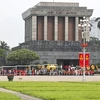Hanoi (VNA) – Up to 84.2 percent of the communes in the capital city of Hanoi have met the standards for new-style rural areas as of April this year.
The city has completed building new-style rural areas two years ahead of the set target after 325 out of its 386 communes achieved all criteria. Currently, there are four new-style rural districts in the city, namely Dan Phuong, Dong Anh, Thanh Tri and Hoai Duc.
According to Nguyen Van Chi, deputy head of the city’s steering office of the new-style rural area building programme, Hanoi is a leading locality in building new-style rural areas, and the programme has cast a new look to the city’s outskirts, and helped improve livelihoods of locals.
Following the land accumulation and consolidation, farmers have shifted to the cultivation of high-economic value crops and orchards. Besides, due attention has been paid to developing traditional craft villages across the city.
Reports from the municipal Department of Agriculture and Rural Development show that after 10 years implementing the Party Committee’s Programme No.02-CTr/TU on branching out agriculture, building new-style rural areas and bettering local farmers’ lives, the added value of the agricultural sector increases 2.5 percent per year on average, while the total value of agro-forestry-fishery production inches up 3.6 percent.
Per capita income rose to 46.5 million VND (1,998 USD) in 2018 from 33 million VND in 2015, and the figure is expected to increase to 49 million VND in the end of this year. In addition, the rate of poor households had been brought down to 1.81 percent in the end of 2018 from 3.65 percent in 2016.
Infrastructure development in rural areas has been well implemented, and even surpasses the set goal. To be more specific, 378 communes have met requirements in transportation standard, up 5 communes from the end of 2018, 384 communes satisfied irrigational system standard, 386 reached electricity standard while school and cultural facility standards have seen the accomplishment of 342 and 373 communes, respectively.
Besides, convenience stores and mini-markets have mushroomed on the edge of the capital city.
According to the municipal Department of Planning and Investment, Hanoi splashed out more than 76.45 trillion VND for local agricultural and rural development from 2011 to June 2019. Especially, State budget worth nearly 26 trillion VND was allocated for 18 districts and communes to carry out the new-style rural area building programme.
The national programme targets the average commune completing at least 15 out of the 19 criteria and no commune should have completed less than five.
Under the programme, facilities like roads, electricity, clean water, schools and medical stations will be developed.
Hanoi authorities recently announced to spend 265 billion VND implementing the local One Commune-One Product (OCOP) programme for the 2019-2020 period, as part of efforts to accelerate the building of new-style rural areas.
According to the plan, 100 percent of OCOP programme managers at commune, district, and municipal level public agencies as well as at organizations, businesses and cooperatives registering for the programme will have to undergo training to improve their building capacity.
Though implementing the initiative later than other localities nationwide, Hanoi is aiming to upgrade between 800 and 1,000 products to meet OCOP standards, of which 500 products are set to be ranked at the municipal level and 100 others at the national level.
The capital city has set a goal of developing at least two eco-craft village models. It will look to improve the local origin tracing system for agro-forestry-fishery goods (https://hn.check.net.vn) and website serving State management and demand-supply connectivity related to Hanoi’s OCOP products (http://nongthonmoihanoi.gov.vn/).
Initially, Hanoi’s OCOP programme will focus on a number of commodity groups, including food, beverage, herbs, fabrics and apparel, souvenir – home decoration, and agricultural tourism. Participating organisations will receive support to invest in machines and equipment for production, design and register their brands, access capital, hire experts, and distribute goods.
Currently, the city has approximately 7,200 products suitable to six OCOP groups. Of the total, there are 2,881 food products (39 percent); 2,417 souvenir – home decoration products (33.5 percent); and 1,396 fabric and apparel products (19.3 percent).
Hanoi holds great potential to make significant progress in implementing the OCOP programme. It has 157 large-scale fields and areas producing high-quality commercial rice, 157ha of fruit trees and over 80ha of tea meeting VietGap standards. The city also has 5,000ha for growing safe vegetables, including 352.7ha applying the VietGap standards and 40ha of organic vegetables.
The city has 76 key poultry breeding communes and 3,232 farms outside residential areas. It has 11 supply chains for safe vegetables and 21 others for products from farm animals.-VNA
VNA

























